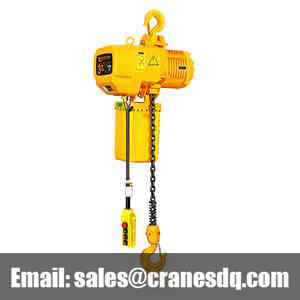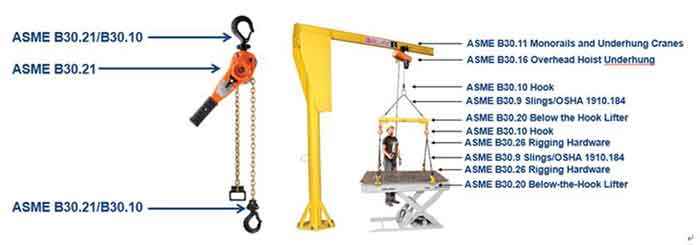As for hoist safety, the pre-operations inspection is very important. How do crane manufacturer inspect your hoist before operation? Generally, the hoist safety inspection before operations concerns the topics, such as, what is the Hoist safety Standards and Regulations? What is the difference between frequent and periodic electric hoist inspection? How to make makings and labels? How to inspect your hoist controls before hoist operation? Operation inspection? How to inspect your hook and chain? Read on for detailed information now.
Types of electric hoists
Lifting capacity:0.1~100ton(0.1 ton, 0.25 ton, 0.5 ton, 1.5 ton, 1 ton, 2 ton, 3 ton, 5 ton, 10 ton, 20 ton, 25t on, 30 ton, 50 ton, 60 ton, 100 ton), lifting height is 3~120m.
Dongqi offers types of electric chain hoist which inculdes electric trolley chain hoist, manual trolley electric chain hoist, and fixed type electric chain hoists, low headroom chain hoist, with different chain falls, etc, Types of electric wire rope hoists including Single speed wire rope hoist, double speed wire rope hoist, exploson proof wire rope hoist, and European standard wire rope hoists, etc.
All Dongqi electric hoists can be supplied with various voltages,such as, 220v hoist, 240v hoist, 380v hoist,etc.
 500kg -35 ton trolley electric chain hoist |  0.5-35 ton Hook electric chain hoist |  0.5 -32 ton wire rope hoist cheap price |  0.5 -80 ton European Standards rope hoist |
Custom designed electric hoists are available from Dongqi Hoist and Crane. Contact to get your custom electric hoists at very pleasant hoist price.The standard electric chain hoist and electric wire rope hoist are in stock which can be delivered quickly. If you need custom desgined electric hoist, please feel free to contact us by email to sales@cranesdq.com.
Hoist safety and hoist inspection:Safety Standards and Regulations
Before hoist inspection, it is important to know and understand all the hoist safety and inspection standards which apply to your hoists. To different types of hoists, different standards are used, which may confuse you for the different regulations are used to different parts of the hoisting system.
Main safety standards to the main parts of the hoists
Besides OSHA regulations, the hoist design and inspection standards provided by ASME needs your attention.
- ASME B30.16. ASME B30.16. Standard is applied to underhung powered hoists, such as, electric hoist and air hoists, and hand chain falls. This hoist standard covers construction, marking, inspection, use, and training.
- ANSI E1.6-2. ANSI E1.6-2.hoist standards is applied in the entertainment industry. It is recommended that if you are in entertainment, it is better to obtain a copy of both hosts’ standards.
- ASME B30.21:ASME B30.21, which applies to lever hoists, including chain, wire rope and strap hoists.
Examples on lever hoist inspection and whole hoisting system
Where it gets complicated is that, in many cases, there are multiple safety standards you need to understand to use or inspect a single hoist.
Example 1: Take the lever hoist inspection for example:
- ASME B30.21 applies to the entire lever hoist
- ASME B30.10 applies to hook inspection, how to use the hook properly, etc.
In this case, you have to understand two standards to ensure proper use and inspection of the lever hoist.

Ex.1. Inspection to the lever hoist, Ex.2. Inspection to the full lifting system
Example 2:Inspection to the full lifting system
Ex.2. is a diagram of all the standards that can affect a single lifting system. Depending on whether you’re an operator or inspector, there are specific parts of these regulations you need to know detail. When in doubt, always check with the equipment manufacturer.
Hoist safety and hoist inspection: Hoist Frequent inspection and Periodic hoist Inspections
Frequent Inspections and Periodic Inspections are the two classes of hoist inspections to ensure your hoist safety.
Frequent Hoist Inspections
Frequent Hoist Inspections are what Pre-Operational Inspections are. Frequent hoist inspections are conducted between the Periodic Inspections The frequent hoist inspections is not required to be recorded, which is commended to be conducted at the start of every shift to ensure safe working order of the hoist. Frequent inspections enable you to detect if anything is wrong with the hoist before lifting a load.
Periodic Hoist Inspections
Periodic Inspections are thorough, detailed hoist inspections, which requires complete disassembly of the hoist.
The periodic hoist inspections are conducted based on the hoist service duty (how often the hoist is used) and hoist application environment. The periodical hoist inspection is required by OSHA, ASME and the hoist manufacturers, which needs to be recorded well to keep on file to ensure your hoisting equipment is safe to use.
How to determine the inspection schedule?
Usually, the hoisting equipment have to be inspected according the service duty, shown in the following table:

If you find a lot of issues with an electric hoist during a Periodic Inspection:
- The number of inspections can be increased each year.
- The hoist operators should be trained to make sure the hoist operation is correct for the electric hoists should not be damaged if they has been used properly. While inspection records don’t need to be maintained for Frequent (Pre-Operational) Inspections, a pre-operational checklist can serve as a quick reference when conducting these inspections.
- Contact us for more information on frequent hoist inspection and periodic hoist inspection.
Hoist safety and hoist inspection:Markings and Labels
- Markings and labels are the places where your hoist needs to check firstly.
- Lock-out tag or label is usually used during the hoist repair and maintenance.
- Tag or plate with hoist identification and capacity information should be checked.
- Warning labels on the hoist should be checked which be kept on the hoist all the time.
Hoist safety and hoist inspection:Controls
Hoist controls is critical to be checked before the hoist operation. If a hoist control is not properly labeled or is not working correctly, injury might occur and damages to the loads might happen. The hoist control should be inspected in two aspects, one is the hoist overall condition the control is in, including clear markings and labels and the second is whether or not the hoist control functions properly. Read on the details on the hoist inspection on controls.
Electric hoist basic: Hoist safety and pre-operation hoist inspection
没有评论:
发表评论